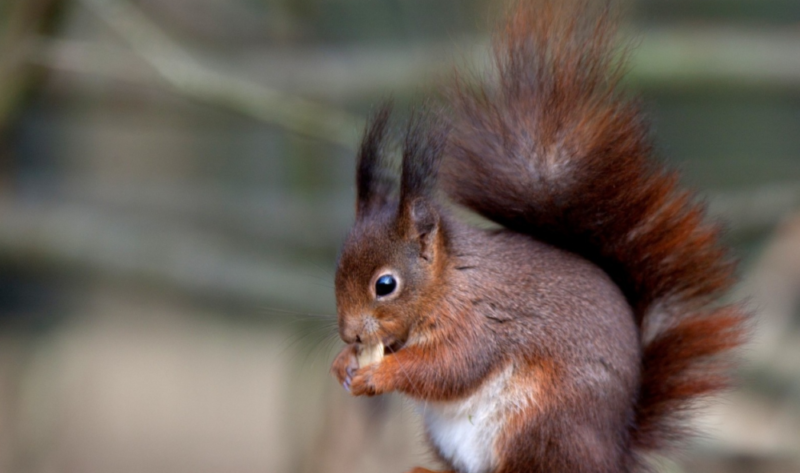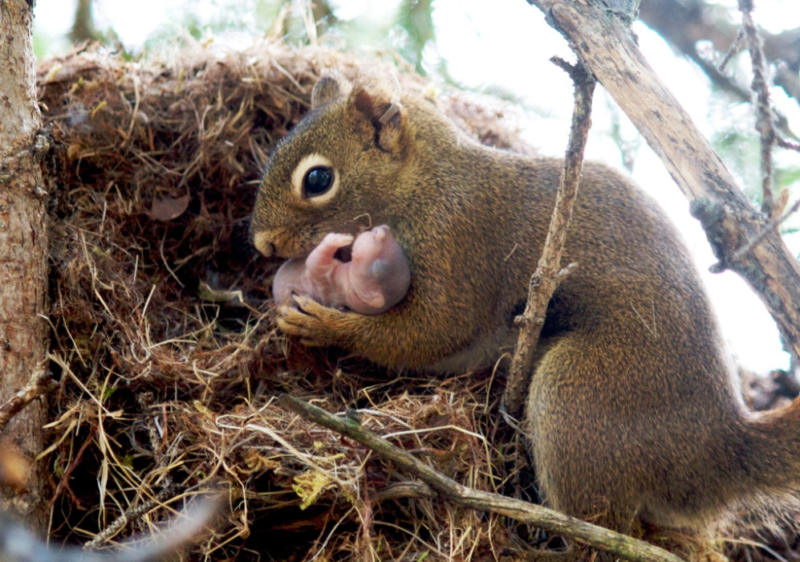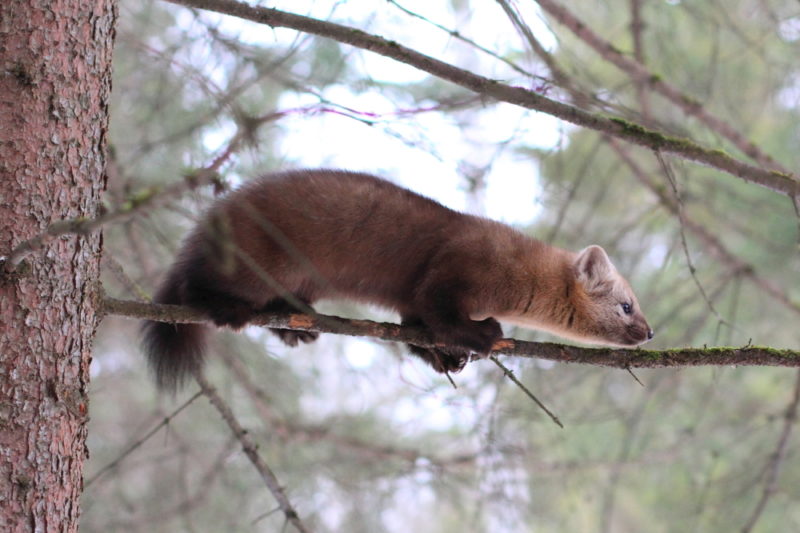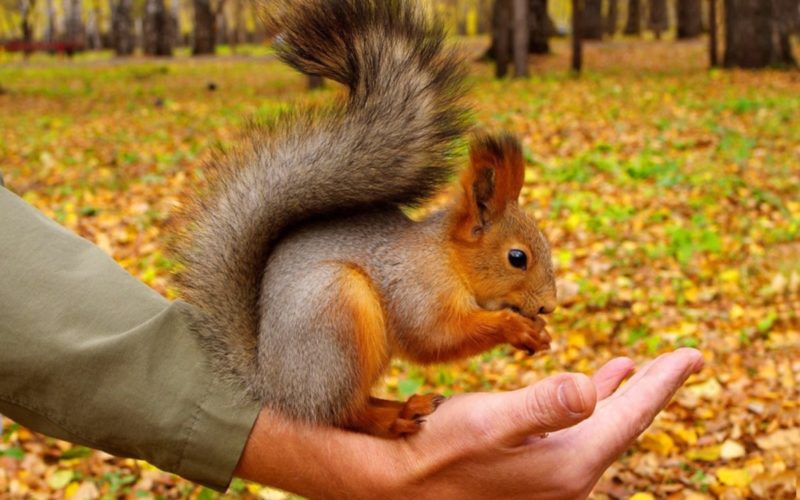The common squirrel is an animal familiar to many from childhood. After all, she often acts as a hero of literary works. And what are the characteristics of the life of the squirrel in the wild? Read below.
Material Content:
Short description of common squirrel
An ordinary squirrel is a small animal with an elongated body and a fluffy tail. The head of the animal is rounded, the eyes are dark, large, long ears end with tassels.
The muzzle, stomach and legs of these creatures are equipped with vibrissae - specific sensory organs, thanks to which the rodent is oriented in space. Fingers with sharp claws, forelimbs slightly shorter than hind limbs.
The average length of the squirrel body is 20-28 cm. About 2/3 is a flat tail. It serves as a helm when jumping. A rodent jumps truly filigree - 3-4 m in length. It is possible that the animal achieves such indicators due to its lightness, because the weight of the protein is only 250-350 g.
The squirrel color is diverse and happens to be red, gray, brown, brown, and sometimes white or black. The tone of the fur coat depends on the place of residence of the animal and seasonality.
Did you know? The Slavs living in ancient Russia called squirrels centuries.
Habitat and habitat
Squirrel is found in almost all areas of Eurasia: from the Atlantic to Hokkaido, including Sakhalin and Kamchatka. This animal lives in the Far East and in Siberia. They also loved the Crimea and the Caucasus.
Squirrel habitat - spruce forests, broad-leaved, mixed, coniferous, fir forests.
Population and species status
The total number of individuals is affected by the yield of the base feed.For this reason, in the hungry years, the number of animals drops tens of times. But after fertile periods there is a real squirrel "baby boom" (up to 400%).
The population of squirrels is changing towards the east and south: for example, in the Moscow Region the number of these animals is 20-90,000 per 1 ha, and in Eastern Siberia - 80-30 000 per 1 ha. The number of veshshas also depends on the habitat: in the cedar forests they are the most abundant.
English and Irish ordinary squirrels were replaced by gray squirrels brought here by humans. It was they who infected their common brethren with poxvirus. In the Caucasus, the situation is the opposite: the veksha literally replaced the Persian squirrel living here from local forests.
Note. The number of animals also largely depends on the fishery. In regions where it is high, the population is updated in 3-4 years. In the same places, increased mortality of young animals is noted: only 15-20% of babies can survive the first winter.
What does protein eat
Squirrel is a kind of foodie who loves variety in food. Her diet may include over 130 names of various goodies, but the main course is, of course, the seeds of conifers. In the south, the animal feasts on acorns and hazel.
In the absence of basic feed, the protein eats shoots, buds, berries and mushrooms. Carved by mating games, vechs become predators, eating chicks, larvae, and eggs.
It is interesting. There are legends about protein storage. Indeed, this animal digs food between the roots or stuffs its home with cones and nuts. They are also able to dry mushrooms, placing them on branches.
One trouble - the squirrel's memory is very short and it immediately forgets about the stored food, sometimes finding it by pure chance. Other forest inhabitants, such as rodents, birds and bears, who willingly eat its stocks, often use this forgetfulness. However, the squirrel is also not easy and is able to find provisions stored under other rodents under a meter-long layer of snow.
The daily rate of food eaten by protein varies depending on seasonality. In winter, these animals eat no more than 35 g, and during the spring high season of mating, this figure reaches 80 g.
Breeding and offspring
Squirrels are extremely prolific creatures and can bring about two litters per year, "southerners" - even up to three. And only Yakut squirrels give birth once a year. The mating season starts in January-March and ends in July-August.
The female squirrel is very popular, because from her heart fight from 3 to 5 potential "suitors". Caring for the "bride", they fight with other males, growl, knock on branches. Mating with one of them, the squirrel lady builds a nest, and sometimes several, where her babies will settle after 35-40 days.
In each litter 3-10 squirrels are born, each of them weighs about 8 g. Newborns are completely naked and blind. After 2 weeks, their body begins to become covered with hairs, and their eyes completely open after a month. The young are fed milk for about 40-50 days and leave the mother, reaching 8-10 weeks. The animal is considered sexually mature at 9-12 months.
Natural enemies
There are many dangers lurking in the forests, it becomes an object of hunting for larger animals.
Squirrel-threatening predators:
- sable;
- owls
- raccoons;
- foxes;
- martens;
- cats.
Helpful information. Biologists are confident that squirrel populations are virtually unaffected by predator attacks. A much greater danger to them is a lack of food and various infections. The latter spread in late autumn or spring. Veksha is constantly suffering from the vital activity of fleas, ticks and worms parasitizing on them. As a result, these cute little animals die in large numbers from coccidiosis and tularemia.
Human interaction
And although proteins are often used by humans as an object of fishing, friendship between them is quite possible. So, many people tame protein and keep them at home.In this case, young individuals and very small squirrels get used to captivity best of all. Pregnant females will need 1-2 weeks to get used to. Most uncomfortable in unusual conditions feel old squirrels.
The best conditions for keeping squirrels are a spacious cage with metal rods, at least 70 cm high. The new dwelling should not be located in a draft, but it should not be in the sun. The cage is equipped with a house or a nest. And also the rodent will need a squirrel wheel for making movements.
At first, it is better to cover the cell with tissue - this way the feels calmer. During molting, animals are less active, a little lethargic.
Occasionally, a protein is released from the cage and allowed to walk around the apartment or room. In this case, you should close all doors and windows, as well as remove objects that could harm the rodent or simply break. They should not be driven back into the cage, it’s best to lure them with tasty nuts or wait until the hungry animal goes to its home itself. Do not leave the squirrel in the room alone. Left to its own devices, it can begin to nibble everything, as well as make food stocks in the most inappropriate places. Of course, when walking squirrels, the cat should be removed from the room.
Fishing value
Squirrel is considered a valuable furry rodent and is one of the most popular objects for fishing. So, in Russia they hunt her in the forests of Siberia, Yakutia and the Urals.
In the Soviet Union, squirrel fur was only sable ahead of the total number of blanks. However, to date, the mass reception of the skins of these rodents is limited and since 2009, the fur is rarely put up for auction.
Interesting Facts
Watching proteins is extremely interesting and informative.
Few people know a number of facts about these animals:
- Proteins are most active in the morning and evening.
- To survive the winter, each protein needs at least 3,000 nuts.
- Born blind squirrels have developed claws.
- Veksha sheds twice a year, however, on the tail, wool is replaced only once during this period.
- Squirrels are single animals, but in winter, to save from severe frosts, they are sometimes grouped in hollows of 3-6 animals.
- Rodents, who managed to live to the age of four, in the wild are recognized as peculiar long-livers. In captivity, animals are able to live for more than 12 years.
- Few lovers of these animals suspect that it is impossible to treat peanuts with peanuts. Proteins included in the treat are not absorbed by the rodent.
- Squirrel's teeth continue to grow throughout her life.
- Of all the senses, squirrels have the most developed hearing.
- Having fallen from a height of 30 m, the squirrel can not suffer at all, she will go about her business enthusiastically. After all, her tail serves as an assistant, which she knows how to use as a parachute.
- A squirrel is able to drown in water if its tail is wet.
- Veksha eats only a quarter of the stockpiles she has prepared for the winter.
- These rodents do not breed in captivity.
- Squirrel meat is prohibited for pregnant women in Croatia.
- The appearance of proteins has remained unchanged for almost 50 million years in a row.
- Squirrels are recognized as the cleanest rodents on the planet.
- For a day, a protein is able to collect about 100 cones and provide itself with food for a month.
- Veksha cannot be found on two continents - in Antarctica and Australia.
- The smallest recognized African squirrel.
- Representatives of the squirrel family perfectly see and navigate in the dark.
- Animals are able to communicate with each other using tail movements. And about the impending danger, these rodents alert their brethren with a piercing sound.
- Squirrel paws are able to rotate at an angle of 180 degrees.
- An angry squirrel, defending himself, stands on its hind legs.
- The smallest vechsa in the world reaches a size of 2.5 cm.
Squirrel is a miniature and cute rodent. This animal is used by man not only as an object of hunting, but also acts as a pet.Thrifty and hardworking, the little sunshine invariably arouses the interest of wildlife lovers.




















